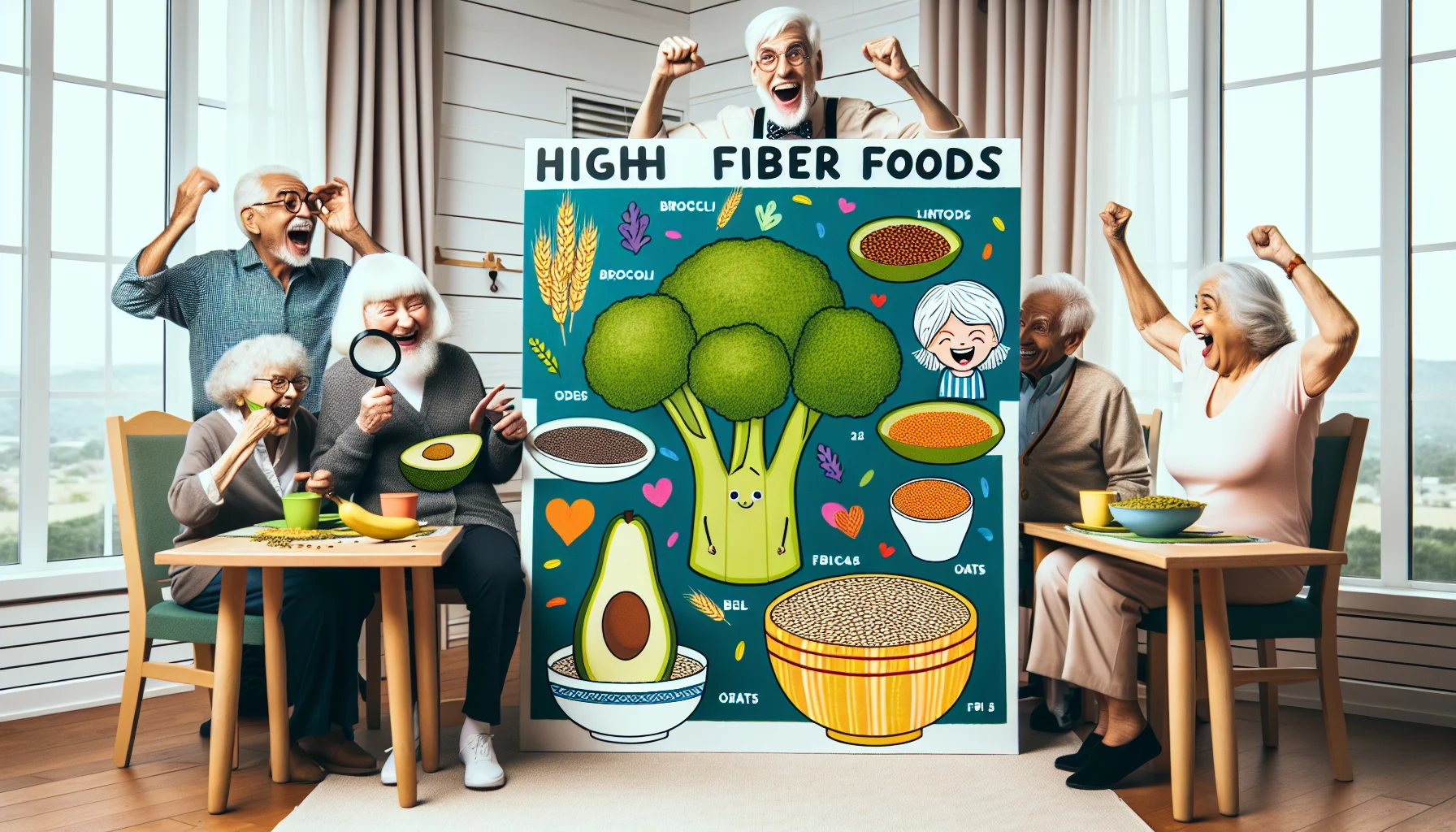List of high fiber foods chart Quiz
Test Your Knowledge
Question of
Understanding Dietary Fiber
Types of Dietary Fiber
Dietary fiber, a plant-based nutrient, is the unsung hero of our diet. It's a complex carbohydrate that remains undigested, sweeping through our digestive system and taking many health benefits along for the ride. There are two primary types of dietary fiber: soluble and insoluble, each with its own unique advantages for our health.
Every balanced diet should include a mix of both types of fiber. A diverse intake ensures that you're not only supporting your digestive system but also catering to the various ways in which fiber interacts with other nutrients and your body's processes. It's the kind of teamwork within your diet that can lead to a healthier life!
Soluble Fiber: Benefits and Sources
Soluble fiber is like nature's sponge it dissolves in water and forms a gel-like substance in the gut. This gel slows digestion, which helps regulate blood sugar levels and can lower cholesterol. It's a key player in weight management too, as it tends to create a feeling of fullness.
When it comes to sourcing soluble fiber, think juicy and fleshy! Foods such as oats, apples, oranges, carrots, and beans are packed with it. Integrating these foods into your meals is not just tasty; it's a strategic move towards better health.
Insoluble Fiber: Health Impacts and Food Examples
Then theres insoluble fiber the bodys natural broom! This type of fiber doesn't dissolve in water; instead, it adds bulk to stool and helps food pass more quickly through the stomach and intestines. Its fantastic for preventing constipation and maintaining bowel health.
To get your fill of insoluble fiber, turn to whole grains like wheat bran, vegetables such as cauliflower and potatoes, and nuts & seeds. These foods not only add texture and crunch to your meals but also provide the essential roughage your digestive system needs.
The Role of Fiber in Digestive Health
Fiber plays a starring role in digestive health. Its ability to move through the digestive tract untouched means it helps other foods along the way, ensuring everything flows smoothly. Think of it as the traffic cop of your gastrointestinal system!
A diet rich in fiber from varied sources can help maintain regularity and prevent the sluggishness often associated with low-fiber diets. It's one piece of the puzzle that promotes overall gut wellness.
How Fiber Aids Digestion
The mechanics of how fiber aids digestion are simple yet impressive. Soluble fiber attracts water into stools, making them softer and easier to pass. This reduces strain during bowel movements and can alleviate or prevent hemorrhoids.
Insoluble fiber adds bulk to waste material, speeding its passage through your gut and minimizing the chance of constipation. Together, these fibers work synergistically to keep you feeling light and energetic.
Preventing Digestive Disorders with High-Fiber Foods
- Eat Plenty of Vegetables: Leafy greens and cruciferous veggies are high in both types of fiber.
- Incorporate Fruits: Apples with skin on provide soluble fiber while berries offer seeds full of insoluble fiber.
- Choose Whole Grains: Swap out refined grains for whole-grain alternatives like brown rice or quinoa for added roughage.
- Add Legumes: Beans, lentils, and peas are excellent sources that double as protein providers.
- Mix Nuts & Seeds: Sprinkle chia seeds or flaxseeds onto meals for an extra fibrous boost.
- Beware Processed Foods: They often lack dietary fiber compared to their whole-food counterparts.
- Moderate Meat Intake: Meats dont contain fiber; balance them with fibrous side dishes.
- Stay Hydrated: Drinking plenty of water aids the movement of fiber through the digestive system.
- Mind Your Portions: Incrementally increase your fiber intake to avoid gas or bloating.
High Fiber Foods for Optimal Health
Vegetables Rich in Fiber
Vegetables are a powerhouse of nutrition, and their fiber content is through the roof! Including a variety of vegetables in your diet is not just good; it's essential for maintaining digestive health and keeping those hunger pangs at bay. From the crunch of a carrot to the tender bite of cooked spinach, vegetables offer a world of tastes and textures.
The diversity of fiber-rich vegetables means there's something for everyone. Whether you're tossing them into a salad, blending them into a smoothie, or simply snacking on them raw, you're doing your body a huge favor. Plus, they're low in calories and brimming with essential vitamins and minerals!
Leafy Greens: Nutritional Profiles and Serving Ideas
Let's talk leafy greens! Spinach, kale, and Swiss chard are not just trendy; they are fiber dynamos that can transform your health. These greens pack a serious punch with vitamins A, C, and K, as well as minerals like iron and calcium.
Are you wondering how to add more leafy greens to your meals? It's simple! Toss them into your morning omelet, blend them into a green smoothie or create a hearty salad. Their versatility makes it easy to boost your daily fiber intake.
Root Vegetables: Fiber Content and Preparation Tips
Root veggies like sweet potatoes, beets, and turnips are not just starchy sides; they're fiber-filled friends that keep your gut happy. They also serve up a helping of antioxidants and essential nutrients like potassium and vitamin B6.
When it comes to preparing these subterranean treasures, roasting brings out their natural sweetness, making them an irresistible addition to any meal. Or try them mashed for a comforting dish that feels like a hug for your stomach!
Fruits with High Fiber Content
Fruits are nature's candy and come with built-in fiber! Enjoying fruits daily can help regulate blood sugar levels, reduce cholesterol absorption, and prevent constipation. Plus, they're hydrating and packed with vitamins.
The beauty of fruit is that it's ready-to-eat nature's convenience food. Grab an apple on your way out or snack on some berries for a quick fiber fix without any fuss!
Berries and Citrus Fruits: Combining Taste and Nutrition
Berries are small but mighty when it comes to fiber content. Strawberries, raspberries, blackberries each one is bursting with flavor and nutritional benefits. They're also loaded with antioxidants that support overall health.
- Eat them fresh: There's nothing like the taste of freshly picked berries.
- Add them to yogurt: For an extra dose of protein and probiotics.
- Freeze them: Frozen berries make great additions to smoothies or as an ice-cold snack.
- Bake with them: Add berries to muffins or pancakes for a delightful treat.
- Make jam: Preserve the goodness by making homemade berry jam.
Apples and Pears: Incorporating Them into Your Diet
Apples and pears are not just fall favorites; they're year-round superstars in the fiber department. An apple or pear a day could really keep the doctor away by contributing to heart health and weight management.
There's no need for complicated recipes here apples and pears are perfect as they are. But if you want to mix things up, try adding slices to salads or baking them for a warm treat on chilly days.
Whole Grains and Legumes Chart
Whole Grains as a Fiber Source
Whole grains are a powerhouse of nutrition, packed with essential fibers that aid in digestion and keep you feeling full longer. They are integral to a balanced diet, reducing the risk of chronic diseases such as type 2 diabetes and heart issues. Including a variety of whole grains in your daily meals ensures a broad spectrum of nutrients.
Incorporating whole grains into your diet can be incredibly easy and delicious. From breakfast cereals to hearty bread, these fiber-rich foods not only support gut health but also play a vital role in maintaining healthy blood sugar levels. Embrace whole grains for an overall health boost and an infusion of energy in your daily life!
Oats and Barley: Cooking Methods and Recipes
Oats aren't just for breakfast! They can be transformed into savory risottos, granola bars, or even added to meatloaf for extra texture. Similarly, barley serves as a fantastic rice substitute or soup enhancer. Both boast versatility and are simple to prepare either by boiling or baking.
Barley and oats shine bright when it comes to their culinary adaptability. Experiment with overnight oats or barley pilafs to discover new favorite dishes. These whole grains invite creativity into the kitchen while providing substantial nutritional benefits.
Quinoa and Brown Rice: Versatility in Meals
Quinoa is not only gluten-free but also contains all nine essential amino acids, making it a complete protein source - a rarity among plant foods. It cooks quickly and can be used in salads, bowls, or as a side dish. Brown rice is another versatile option, perfect as a base for stir-fries or stuffed peppers.
Rich in vitamins and minerals, quinoa and brown rice are staples that should not be overlooked. Their mild flavors make them excellent canvases for spices and sauces, allowing them to pair well with virtually any ingredient.
Legumes and Their Nutritional Value
Legumes are nutritional giants, offering an abundance of proteins, fibers, vitamins, and minerals while being low in fat. Regular consumption of legumes is linked with lower cholesterol levels and improved heart health. They're an affordable protein alternative for vegetarians and meat-eaters alike.
The variety within the legume family means there's something for everyone from kidney beans to black-eyed peas. Each type brings its own unique flavor profile and benefits, such as iron from lentils or antioxidants from black beans.
Beans and Lentils: Portion Sizes and Cooking Tips
- Rinse Thoroughly: Always rinse beans and lentils before cooking to remove any dirt or impurities.
- Soak Overnight: Soaking beans overnight can reduce cooking time significantly while also making them easier to digest.
- Cooking Time: Lentils generally cook faster than beans; adjust your cooking times accordingly.
- Spice Wisely: Beans absorb flavors well; season generously with herbs and spices during the cooking process.
- Serve Appropriately: Consider portion sizes based on dietary needs legumes are nutrient-dense but also calorie-rich.
- Variety Matters: Rotate between different types of beans and lentils to maintain variety in your diet.
- Avoid Salt Early On: Adding salt early in the cooking process can toughen beans; wait until they're nearly done before seasoning.
- Avoid Acidic Foods: Acidic ingredients like tomatoes can prevent beans from softening; add these later in the cooking process.
- Fresh Water: Cook legumes in fresh water rather than soaking liquid to avoid any off flavors.
- Bloating Concerns: Introduce legumes gradually into your diet to minimize gastrointestinal discomfort commonly associated with fiber intake.
Peas and Chickpeas: Snack Ideas and Salad Additions
Dried peas can be transformed into satisfying snacks like crunchy roasted peas seasoned with your favorite spices. Chickpeas offer similar versatility think hummus dips or falafel balls! Both are fantastic sources of plant-based protein that can enhance any snack time or meal prep routine.
Add chickpeas or green peas to salads for a nutritious crunch that's both filling and flavorful. These legumes pair wonderfully with other salad staples like leafy greens, nuts, and vinaigrettes, making them invaluable additions for those seeking healthy yet satisfying meal options.
Nuts and Seeds High in Fiber
Nutrient-Dense Nuts
When it comes to fiber-rich foods, nuts are superstars. Not only do they pack a punch of fiber, but they're also loaded with healthy fats, proteins, and vital nutrients. Integrating a variety of nuts into your diet can contribute significantly to your daily fiber intake while offering numerous other health benefits.
Nuts like almonds and walnuts are easily accessible and can be enjoyed in many forms. A handful of these can help you feel full for longer due to their high fiber content. They're not just tasty; they're also champions for your heart health, thanks to their omega-3 fatty acids and antioxidants.
Almonds and Walnuts: Snacking and Heart Health
Almonds are dietary dynamos, providing a substantial amount of fiber in just a small serving. They're perfect for on-the-go snacking or as an addition to oatmeal or yogurt. Walnuts are another heart-healthy option, known for their high omega-3 content which supports cardiovascular wellness.
Eating these nuts regularly can improve blood lipid profiles, potentially reducing the risk of heart disease. Their versatility makes them an excellent choice for anyone looking to boost their daily fiber intake while nurturing their heart.
Chia Seeds and Flaxseeds: Smoothies and Baking Uses
Chia seeds and flaxseeds might be tiny, but they are mighty in terms of nutritional value. These seeds are bursting with fiber, making them fantastic additions to smoothies, baking recipes, or even as a pudding base when soaked. Chia seeds absorb water and expand, which can aid in feeling fuller for longer periods.
Flaxseeds are equally impressive with their high-fiber content that promotes digestive health. Ground flaxseeds can be easily incorporated into baked goods or sprinkled over salads for an extra dose of fiber and nutrients.
Seeds for Daily Fiber Intake
Seeds are incredibly versatile ingredients that offer more than just a crunch; they deliver essential fibers that help regulate digestion. Adding seeds like pumpkin or sunflower seeds to your diet is an effortless way to increase your daily fiber intake while enjoying a range of flavors and textures.
Incorporating various seeds into your meals not only enriches the taste but also contributes significantly to meeting your dietary fiber goals. They provide the necessary roughage that helps maintain gut health and can keep you feeling satiated between meals.
Pumpkin Seeds and Sunflower Seeds: Roasting and Garnishing
Pumpkin seeds aren't just for Halloween; they're packed with fiber and can be enjoyed year-round. Try roasting them with spices for a savory snack or adding them to granola mixes. Sunflower seeds offer similar benefitsgreat when tossed into salads or baked into bread for added texture.
- Rinse well: Clean seeds thoroughly before roasting to avoid bitterness.
- Add flavor: Use spices like paprika or cinnamon before roasting to enhance taste.
- Watch the temperature: Roast at a medium heat to prevent burning and preserve nutrients.
- Store properly: Keep roasted seeds in an airtight container to maintain freshness.
Sesame Seeds and Hemp Seeds: Dressings and Dips
Sesame seeds add a nutty flavor and a delicate crunch to any dish; sprinkle them over stir-fries or blend them into tahini for dressings. Hemp seeds are another nutrient-dense option that provides both fiber and proteinideal for enriching dips or smoothies with their mild, nutty flavor.
Their small size belies the significant impact sesame and hemp seeds can have on your nutrition. They're easy to integrate into daily meals, ensuring you get that extra boost of fiber without compromising on taste or convenience.
Incorporating High-Fiber Foods into Your Diet
Breakfast Ideas with High Fiber
High-Fiber Cereals and Porridges: Starting Your Day Right
Kick off your day with a bang! High-fiber cereals are not just nutritious, they're incredibly versatile. Choose from bran flakes, oatmeal, or barley, and boost the fiber content even more by adding nuts and seeds. Remember, a high-fiber breakfast can help regulate digestion and keep you feeling full longer.
Porridge doesn't have to be boring. Quinoa and millet are fantastic alternatives to oats, offering a protein punch along with that all-important fiber. Sweeten them naturally with fruit and steer clear of added sugars for the most healthful start to your day.
Yogurt Parfaits and Smoothie Bowls: Creative Combinations
Transform your morning routine with yogurt parfaits layered with high-fiber fruits like berries, kiwi, or apple slices. Mix in chia seeds or flaxseeds for an extra fiber kick. These delicious layers not only tantalize the taste buds but also contribute to your daily fiber goal.
Smoothie bowls are an explosion of flavor and fiber! Blend leafy greens like spinach or kale with high-fiber fruits such as banana or mango. Top it off with granola or nuts, and you've got a meal that's as visually appealing as it is beneficial for your digestive health.
Lunch and Dinner Solutions
Salads and Soups: Balancing Meals with Fiber
Lunchtime is a fantastic opportunity to pack in dietary fiber. Salads loaded with fresh vegetables, beans, and whole grains are not only scrumptious but also immensely satisfying. Drizzle some olive oil-based dressing for healthy fats that can enhance nutrient absorption.
Soups are comfort in a bowl especially when they're brimming with fiber-rich ingredients like lentils, peas, and broccoli. They're easy to prepare in large batches ensuring you have hearty meals ready throughout the week. Plus, they're perfect for warming up on chilly days!
Stir-Fries and Casseroles: Integrating Whole Foods
Dinner sizzles with stir-fries packed full of fibrous veggies like bell peppers, carrots, and snap peas. Toss in some tofu or chicken for protein, serve over brown rice or quinoa, and you've created a nutrient-dense meal that ticks all the boxes for taste and health benefits.
- Maintain variety: Use different vegetables each time to keep meals exciting.
- Bulk it up: Add beans or legumes to increase both protein and fiber content.
- Cook smart: Use healthy oils sparingly and opt for steaming or baking over frying.
- Taste matters: Use herbs and spices generously to enhance flavor without adding excess calories.
- Plan ahead: Prepare ingredients beforehand for quick assembly on busy nights.
- Leftovers are golden: Make extra servings for convenient next-day lunches.
Special Diets and Fiber Requirements
Gluten-Free High-Fiber Options
Embarking on a gluten-free journey doesn't mean you have to compromise on fiber. There's a treasure trove of nutrient-rich, gluten-free foods that are naturally high in fiber. From fruits and vegetables to nuts and seeds, these dietary staples are not only delicious but also pivotal for digestive health. Embrace the variety and keep your gut happy!
Finding high-fiber, gluten-free substitutes can be a game-changer for those with celiac disease or gluten sensitivity. Quinoa, buckwheat, and amaranth are power-packed alternatives that bring both flavor and fiber to the table. They're versatile, so you can sprinkle them into any meal - breakfast, lunch, or dinner - and boost your daily fiber intake effortlessly.
Gluten-Free Grains and Their Fiber Content
When it comes to gluten-free grains, it's essential to know your champions. Brown rice leads the pack with its impressive fiber content, closely followed by wild rice and millet. Each of these grains offers a unique texture and taste while contributing significantly to your daily fiber goals. Get creative in the kitchen and let these grains elevate your meals!
Millet is not just for birds; it's a gluten-free superstar! With 1.7 grams of fiber per 100 grams, millet is a fantastic choice for anyone looking to up their fiber intake without gluten. Teff, with 2.8 grams per 100 grams, packs a hefty fiber punch too. These grains are nutritional powerhouses that deserve a prime spot in your pantry.
Navigating Fiber Intake on a Gluten-Free Diet
Managing your fiber intake while on a gluten-free diet can seem daunting at first glance. However, with careful planning and strategic food choices, you can hit your daily targets without worry. Incorporate a variety of high-fiber fruits like berries and pears along with vegetables such as broccoli and Brussels sprouts to keep things running smoothly.
- Read Labels: Always check product labels for hidden sources of gluten and fiber content.
- Diversify Your Plate: Include different types of fruits, vegetables, legumes, nuts, and seeds in your meals.
- Befriend Legumes: Chickpeas, lentils, and beans are not only gluten-free but also rich in fiber.
- Plan Meals: Pre-planning meals ensures you'll have the right balance of nutrients throughout the day.
- Consult Nutrition Apps: Use apps to track both your gluten intake and daily fiber goals.
High-Fiber Foods for Vegetarians and Vegans
Vegans and vegetarians rejoice! The plant kingdom is brimming with fibrous delights that cater perfectly to your dietary preferences. Dark leafy greens like spinach and kale are not just packed with vitamins but also contain ample fiber to meet your needs. And let's not forget about the humble apple; one apple with skin provides about 4 grams of dietary fiber!
Your body will thank you for incorporating a variety of legumes into your vegetarian or vegan diet. Black beans, lentils, chickpeas they're all loaded with both protein and fiber. They make excellent bases for hearty soups, stews, salads, or even as the main ingredient in veggie burgers. Get ready for some serious satisfaction without compromising on nutrition!
Plant-Based Protein Sources with Fiber
Finding plant-based protein sources that also offer fiber is like hitting the nutritional jackpot! Tofu is an incredible option that provides about 2 grams of dietary fiber per 100-gram serving while packing in the protein. Edamame beans are another dual-threat snack munch on them between meals for a protein-fiber combo that keeps hunger at bay.
Nuts and seeds should be staples in every vegetarian's pantry due to their high protein and fiber content. Chia seeds boast an impressive 34 grams of fiber per 100 grams! Almonds aren't far behind they're not only heart-healthy but provide about 12 grams of protein alongside their fibrous benefits per 100-gram serving.
Balancing Macronutrients in a Vegetarian Diet
Balancing macronutrients is crucial for vegetarians to maintain energy levels throughout the day while ensuring proper nutrition. Integrating complex carbohydrates like quinoa or sweet potatoes provides sustained energy along with valuable dietary fiber. Pair these carbs with healthy fats from avocados or olive oil for a well-rounded meal that supports overall health.
A well-planned vegetarian diet featuring diverse sources of macronutrients can promote optimal health while satisfying hunger pangs. Combine different food groups - think grains paired with legumes or seeds mixed into salads - for meals that are balanced in carbohydrates, proteins, fats...and don't forget the all-important FIBER! Keep it colorful, keep it diverseyour body will love you for it!
Measuring Your Fiber Intake
Daily Recommended Fiber Intake
The importance of fiber in your diet cannot be overstated, and knowing the daily recommended intake is crucial. For adults, women should aim for 25 grams per day, while men should target 38 grams. These values can decrease slightly as you age. Children's requirements vary, so consult pediatric guidelines.
Understanding age and gender-specific recommendations helps tailor fiber intake for optimal health benefits. For instance, women under 50 need more fiber than those over 50 due to different metabolic needs. Men have higher recommendations due to larger average body size and caloric intake.
Understanding Age and Gender-Specific Recommendations
Tracking fiber consumption through food diaries can be transformative. It allows you to quantify your intake and identify foods that help meet your goals. Apps and nutrition labels are handy tools for this purpose.
A food diary doesn't just count calories; it's a revelation of dietary habits. By logging meals, you can ensure that youre consistently meeting the recommended fiber intake. This simple habit could lead to significant improvements in your digestive health and overall well-being.
Signs of Inadequate Fiber Intake
Recognizing symptoms of low fiber intake is key to maintaining digestive health. Signs include constipation, weight gain from overeating, and high cholesterol levels. These symptoms highlight the need for dietary adjustments.
If you're experiencing irregular bowel movements or feeling unsatisfied after meals, it might be time to assess your fiber consumption. Increased whole grains, fruits, and vegetables can help alleviate these issues.
Adjusting Your Diet to Increase Fiber
- Incorporate a variety of fruits and vegetables: Aim for at least five servings per day to boost both soluble and insoluble fiber.
- Choose whole grains: Swap out refined grains with their whole counterparts like brown rice, quinoa, and whole wheat bread.
- Add legumes to your meals: Beans, lentils, and chickpeas are excellent sources of fiber and also pack a protein punch.
- Sneak in fiber-rich snacks: Nuts, seeds, and popcorn are great options for a midday snack that keeps you full and adds to your daily fiber count.
- Beware of processed foods: They often contain less fiber than their unprocessed equivalents. Always read labels carefully!
An adjustment in diet can significantly increase your daily fiber intake. Start by introducing high-fiber options at every meal; this could mean adding fruit to breakfast cereal or mixing beans into a salad or soup for lunch or dinner. Small changes accumulate to make a substantial impact on your health.
Making these dietary changes isn't just about hitting numbers; it's about creating sustainable habits that lead to long-term health benefits. High-fiber foods tend to be more filling and offer more nutrientsmaking them an excellent choice for anyone looking to improve their diet quality.
Prebiotics, Probiotics, and Fiber Synergy
The Importance of Prebiotics in Your Diet
Prebiotics are essential for maintaining a healthy gut microbiome. These non-digestible fibers act as food for beneficial bacteria, supporting their growth and activity. A diet rich in prebiotics can lead to improved digestion, enhanced immune function, and reduced risk of chronic diseases. The synergy between prebiotics and probiotics is like a catalyst for overall wellness.
Without prebiotics, probiotics cannot thrive. This symbiotic relationship shapes our body's ability to fend off pathogens and extract nutrients from food. It's not just about consuming the right microbes; it's also about feeding them properly. Prebiotics lay the groundwork for a robust intestinal environment where health-promoting bacteria can prosper.
Identifying Prebiotic Foods and Their Functions
Prebiotic foods often fly under the radar but are found in everyday dietary staples such as garlic, onions, bananas, and whole grains. These foods contain compounds like inulin and oligosaccharides that resist digestion and reach the colon intact to nourish gut bacteria. By including these foods in your diet, you're deploying an army of nutrients that bolster your gut flora.
Incorporating prebiotic-rich foods into your meals is simple yet transformative. They not only promote gut health but also contribute to satiety, blood sugar control, and cardiovascular health. The diverse functions of prebiotics extend far beyond the digestive system, influencing various aspects of bodily function.
Combining Prebiotics with Probiotic Foods for Gut Health
Merging prebiotic with probiotic foods amplifies their health benefits exponentially. This dynamic duo works together to enhance gut barrier function, reduce inflammation, and support the immune system. Eating a balanced mix of both ensures that you're not just introducing beneficial microbes but also providing them with the resources they need to succeed.
- Banana with yogurt: The prebiotic-rich banana complements the probiotic cultures in yogurt.
- Sourdough bread: Often made with probiotic yeast and pairs well with prebiotic-rich toppings like avocado.
- Miso soup: Combines the probiotic benefits of fermented miso paste with prebiotic-rich vegetables.
- Kefir smoothies: Blend kefir with fruits like berries or kiwi for a prebiotic boost.
Enhancing Digestive Health with Probiotic-Rich Foods
Probiotics are live microorganisms that offer immense digestive benefits when consumed in adequate amounts. These beneficial bacteria help restore the natural balance of gut flora that can be disrupted by factors such as poor diet or antibiotic use. Regular consumption of probiotic-rich foods can lead to better nutrient absorption, reduced gastrointestinal issues, and a stronger immune system.
To truly harness the power of probiotics, consistency is key. Integrating these foods into your daily routine can create lasting impacts on digestive wellness. It's not just about occasional consumption; it's about making these microbial allies a staple in your culinary repertoire for continued gut health support.
Fermented Foods as a Source of Probiotics
Fermented foods are treasure troves of probiotics. Traditional delicacies like kimchi, sauerkraut, kefir, and kombucha are not just culinary trends; they are vessels carrying diverse bacterial strains that contribute to our microbiome diversity. The fermentation process also enhances the bioavailability of nutrients in these foods, making them even more beneficial for our health.
The variety of fermented foods available means there's something for everyone's palate while contributing to their microbial wellbeing. From tangy pickles to creamy yogurts, these fermented delights are not only delicious but also serve as functional foods that support our internal ecosystem.
Incorporating Probiotics into Meals for Digestive Balance
Including probiotics in meals doesn't have to be complicated or disrupt your favorite dishes. Simple swaps or additions can effectively introduce these friendly bacteria into your diet. For instance, topping salads with sauerkraut or adding kefir into smoothies increases both flavor complexity and nutritional value.
Creative culinary experimentation can make consuming probiotics an exciting adventure rather than a dietary chore. With each meal containing these microbe-packed ingredients comes an opportunity to bolster your digestive system's health while enjoying the rich tastes they offer.












